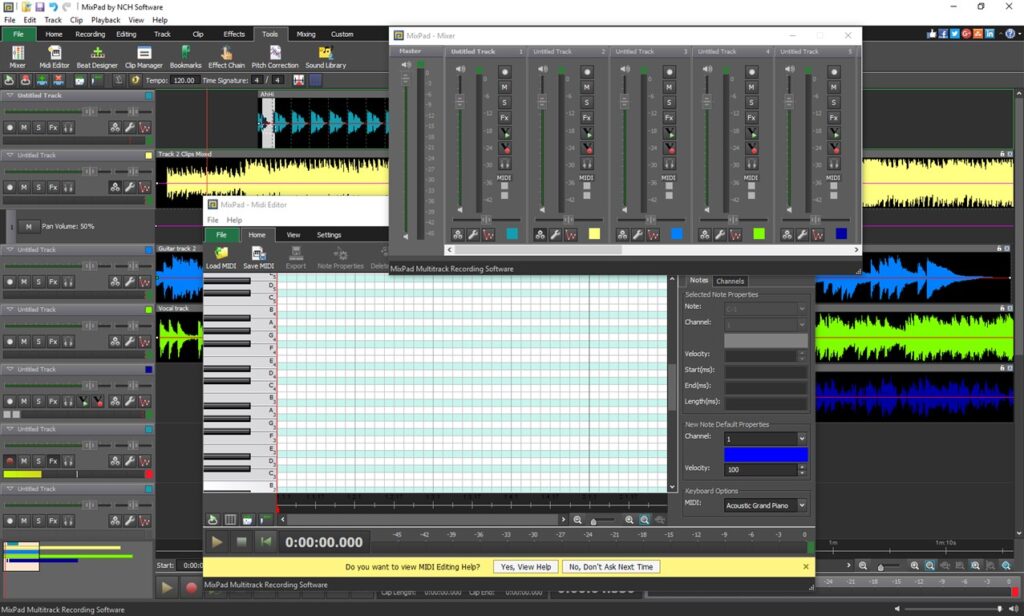Mixpad multitrack recording software free download with crack
MixPad is a powerful and user-friendly multitrack recording software that allows you to create professional-sounding audio projects.
Whether you’re a seasoned musician, a podcast host, or simply someone who enjoys experimenting with sound, MixPad offers a comprehensive suite of tools to help you achieve your audio goals.
This step-by-step guide will walk you through the basics of using MixPad, covering everything from importing audio to mastering your final mix.
Step 1: Download and Install MixPad
Visit the official MixPad website (www.mixpad.com) and download the software.
Choose the appropriate version for your operating system (Windows, Mac, or Linux).
Run the downloaded installer and follow the on-screen instructions to complete the installation.
Step 2: Create a New Project
Launch MixPad and click on “New Project” to start a new audio project.
Choose the desired sample rate and bit depth for your project.
You can also select a specific template for your project, such as a music template or a podcast template.
Step 3: Import Audio Files
Click on the “Add Audio” button or drag and drop your audio files directly into the MixPad window.
You can import various audio formats, including MP3, WAV, AIFF, and more.
Once imported, your audio files will appear as tracks in the MixPad timeline.
Step 4: Arrange and Edit Your Tracks
Use the mouse to drag and drop tracks to rearrange them in the timeline.
You can trim, cut, copy, paste, and delete audio segments using the editing tools available in MixPad.
You can also adjust the volume, pan, and pitch of individual tracks.
Step 5: Add Effects and Enhancements
MixPad offers a wide range of audio effects, including reverb, delay, equalization, compression, and more.
To apply an effect, simply select the track and click on the “Effects” tab.
Choose the desired effect and adjust its parameters to achieve the desired sound.
Step 6: Mix and Master Your Audio
Use the mixer panel to adjust the volume and pan of each track.
Experiment with different effects and settings to create a balanced and professional-sounding mix.
Once you’re satisfied with your mix, you can master your audio by applying final touches such as limiting, equalization, and compression.
Step 7: Export Your Project
When you’re ready to share your audio project, click on the “Export” button.
Choose the desired output format (MP3, WAV, AIFF, etc.) and adjust the settings as needed.
Click on “Export” to save your final audio file.
Additional Tips:
Utilize the Help Menu: MixPad offers extensive documentation and tutorials that can help you learn more about its features.
Experiment with Different Settings: Don’t be afraid to experiment with different effects, settings, and techniques to find what works best for your audio project.
Practice Makes Perfect: The more you use MixPad, the more comfortable you’ll become with its features and functionalities.

Features
- Multitrack Recording: Mixpad enables users to record multiple audio tracks simultaneously, allowing for seamless collaboration and the creation of complex audio projects.
- Audio Editing: The software offers a comprehensive set of editing tools, including trimming, cutting, copying, pasting, and volume adjustments, making it easy to fine-tune your audio recordings.
- Effects and Plugins: Mixpad comes loaded with a variety of built-in effects and plugins, such as reverb, delay, and equalization, empowering users to enhance the quality and character of their audio.
- Mixing and Mastering: The software’s robust mixing console and advanced mastering tools provide users with the ability to meticulously balance and optimize their audio recordings.
- MIDI Support: Mixpad allows users to integrate MIDI instruments and controllers, expanding the creative possibilities for music production and sound design.
Technical Specifications:
- Version: 7.1.2
- Interface Language: English, German, French, Spanish, and others
- Audio Language: Supports multiple languages
- Uploader/Repacker Group: Mixpad
- File Name: Mixpad_7.1.2_Crack.zip
- Download Size: 45.8 MB
System Requirements:
Windows
- Operating System: Windows 7/8/10/11
- Processor: Intel Core 2 Duo or AMD Athlon 64 X2
- RAM: 2 GB or more
- Storage: 200 MB of available disk space
Mac:
- Operating System: macOS 10.11 or later
- Processor: Intel Core 2 Duo or later
- RAM: 2 GB or more
- Storage: 200 MB of available disk space
Android:
- Operating System: Android 5.0 or later
- RAM: 2 GB or more
- Storage: 200 MB of available disk space

Adjusting Graphics Settings:
- Open Mixpad and navigate to the “Options” menu.
- Select the “Graphics” tab.
- Adjust the settings, such as resolution, bit depth, and frame rate, to optimize performance on your system.
Troubleshooting Common Issues:
- If you encounter any installation or compatibility issues, try running the installer as an administrator.
- If the software is experiencing performance problems, try closing other running applications or adjusting the graphics settings.
- For any other issues, consult the Mixpad support documentation or reach out to the developers for assistance.
How to Use Mixpad:
- Launch the Mixpad software.
- Create a new project or open an existing one.
- Adjust the settings, such as the sample rate and bit depth, to match your audio requirements.
- Import or record your audio tracks.
- Use the various editing, mixing, and mastering tools to refine your audio.
- Export your final project in the desired format.
For more information, you can visit the following websites:
These websites offer unique resources and insights, so feel free to explore them to find the information you need.

Leave a Reply